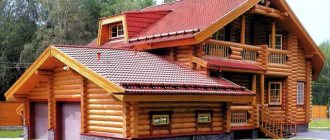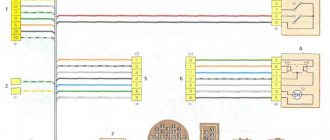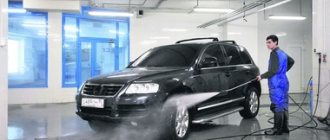Each car has its own strengths and weaknesses. And this is well known to every car owner who knows his car from A to Z. Recently, a very common problem in many cars (both foreign and domestic) is rotting of the rear arches. Yes, this is their weakness, or in other words, a disease that needs to be treated in order to prevent further development.
The rear arches of a car are an ideal place for corrosion to develop and spread. To prevent your car from rotting, you need to use liquid fender liners, which you can apply yourself without turning to a service station for help.
Liquid fender liners are a special anti-corrosion material that serves to protect wheel arches and is characterized by high resistance to sandblasting. It must be applied in several layers, with the thickness of one layer being 2-3 mm.
Thanks to liquid fender liners, the wear resistance of the car increases, the level of dirt in glasses and noise due to wheels is reduced by up to 45-48%. The characteristic feature and highlight of liquid fender liners is not just the reflection of noise, but its absorption.
What are fender liners?
Not all car owners know what these elements look like. Fender liners or lockers are metal or plastic casings. The main task of these lockers is to protect car wheel arches from various mechanical damages. On most car models, regardless of manufacturer, the rear arch is especially vulnerable. In addition, with the help of fender liners, manufacturers improve noise insulation and dynamic characteristics of the car.
On new models, serial rear fender liners are installed by the manufacturer. They can be either hard or liquid. Solid fender liners are classic products made of plastic or metal. Liquid are special protective coatings that are applied to the surface of the arch and then harden. The disadvantage of liquid fender liners is that during operation their protective layer wears off very quickly. For full protection, it should be applied several times throughout the year.
As for solid rear fender liners, their service life is much longer. However, the downside is that in most services they are installed using self-tapping screws. If there are no standard technological holes in the wheel arch, then they have to be made, and this entails corrosion of the front and rear fenders.
There is a category of car owners who consider this part completely unnecessary - manufacturers do not install lockers on cars in the “economy” class. But experts believe that every car needs lockers, not only on the rear wheels, but also on the front arches.
Types of door corrosion
Corrosion can only be conditionally divided into several types according to the degree of damage that rust has already caused to the metal. Depending on this, various types of repairs and subsequent anti-corrosion protection will be used. Drivers face the following problems:
- Blistering of the paintwork on the outer surface. Even though the paintwork is not damaged, this does not mean that there is no rust under the paint layer. In 60% of cases, drivers discover a significant area of corrosion, a hole through it, after cleaning the surface.
- Visible streaks of rust on the bottom of the door. The defect occurs at the site of a chip or microcrack in the paintwork. In this case, rot penetrates both into the inner pocket and onto the threshold.
- Significant areas of corrosion along the lower edge of the door. Such a defect does not appear in one day, but if the car spent the winter outside under a simple awning and was not used, then in 3 months of winter corrosion can cover the entire part and affect the elements of the bottom.
Local repairs without the use of welding are carried out if rust appears in a microcrack in the paintwork or at the site of a chip, but does not destroy the metal. In other cases, a metal patch or door replacement will be required.
Solid fender liner materials
Manufacturers of auto accessories make rear fender liners from the following materials - plastic, aluminum, galvanized steel. By the way, the latter are losing their popularity today.
Plastic products are made mainly from polyethylene, the so-called ABS plastic, as well as fiberglass. The most common among them are models made of polyethylene. They very reliably protect the metal surfaces of the body from the destructive effects of various chemical materials, and perfectly protect the body from impacts. The material has high elasticity and does not crack at low temperatures. In addition, polyethylene can be welded and soldered.
The fender liner is made in such a way that it completely repeats the shape of the wheel arch of a specific car model. The product can be either solid or cut. Thus, the peculiarity of the rear fender liners on Mazda is that they are mounted in an arch with a protruding pillar. This design facilitates the process of installation and dismantling of the product.
Plastic products have another advantage over metal ones - an increased level of safety. If for some reason the wheel arch liner gets under the wheel, the material will break. A metal product can cause significant damage to a tire or car. If the part is wrapped, it can easily block the wheel.
Preventing car door corrosion
Before treating car fender liners for corrosion, cleaning doors, or changing thresholds, it is necessary to conduct a metal diagnosis. Tap the parts with a hammer and check for minimal traces of rust. Preventative measures against corrosion can be divided into the following types:
- Passive protection. The body element is cleaned of dirt, dried, and treated with bitumen mastic. A paraffin-based anticorrosive agent is used for the outer surface; an oil composition must be poured into the closed cavity.
- Active transformative prevention. For protection, not just anticorrosives are used, but compositions that displace moisture like Moville with preservatives for primary rust spots. Body elements are treated with liquid compounds, and after drying, a protective film is formed. The main condition for using Movil is the absence of synthetic seals in the doors; the aggressive composition destroys rubber bands and plastic linings.
- Comprehensive prevention involves the use of both anticorrosion agents and the treatment of metal with a primer after preliminary cleaning of the body element.
- Galvanization. An expensive production method for protecting a car body from corrosion. Many brands hot-dip galvanize at the assembly stage, so doors, sills, and the underbody of the car are rust-resistant. Volvo shows the best results. Brand cars do not rot after 15 years of operation. At home, you can use a primer with a high zinc content.
- Constructive protection. A modern way to prevent corrosion is to install a system on the car that controls the flow of electrons on the metal surface. These cathodic, anodic, and electronic protection devices are used on premium segment models.
- Lamination, installation of overlays. Protecting the door from rust with a film is aimed primarily at preventing chips on the paintwork from flying gravel. Automotive anti-corrosion film is applied independently, the service life of the film is up to 1.5 years.
Whatever segment the car belongs to, rust prevention by any method helps to avoid expensive repairs and saves time. The use of overlays and lamination help emphasize the style.
Features of choosing fender liners
When choosing the described devices, it is necessary to pay attention to the shape of the product and the material. So, most often fender liners are selected according to the code - sometimes the code and the product itself may not match.
By the way, when purchasing rear fender liners for a Renault or any other car, you need to check the products for strength. If the part is excessively soft or there are deformations, this indicates that the fender liner is made of recycled plastic. These products can sag in hot weather, and in cold winter they can become cracked and destroyed.
Installation
It is better and easier to install protection for wheel arches or fender liners when the car is jacked up or on a lift. For convenience, it is better to remove the rear wheels. Then you should clean the arch. To do this, remove dirt from the surface of the body with a metal brush. After cleaning with a brush, you can blow out the arch with compressed air. It is not necessary to wash your car with water and detergents.
Each fender liner is carefully tried on. The part must fit as accurately as possible into the arch of the car. If there are slight discrepancies in the relief, then you can adjust the part using heating. When heated by a hairdryer, the plastic is easily deformed and takes the desired shape. After this operation, the tires will no longer touch the lockers even with the front wheel fully turned. On the rear wheels there are usually no problems with fitting the lockers.
Preparation, sound insulation
Protecting the arches begins with washing the inside of the mudguard and thoroughly drying it. Then the entire surface is degreased. Option for good sound insulation of wheel arches:
- A vibration-absorbing layer is glued onto the entire surface of the mudguard, covered by the locker you purchased (for example, Shumoff L3 or M3. It needs to be heated before pasting). The sheets are rolled tightly with a metal roller. In this case, the standard anti-gravel coating does not need to be removed;
- Mastic is applied on top with a brush or spray. If desired, you can put it in 2-3 layers, but at the same time, allow 10-15 minutes of drying between layers. at a temperature of +20ºС;
- plastic lockers are covered with noise-absorbing material (for example, Shumoff Germeton A15). Also at this stage, soundproofing sheets based on foam rubber can be used (as an option - Shumoff Comfort 6).
Mounting method depending on design
Most one-piece rear fender liners on Fords or other models are mounted the same way. Self-tapping screws are used for installation - five are enough at the edges of the rear fender, as well as from one to three for fastening in the depth of the wheel tire. In the case of split fender liners, sometimes it is necessary to secure the lower part as well. But it is better, as already mentioned, to avoid fender liners where self-tapping screws are used for fastening. It is worth purchasing those models where installation is carried out with latches. But even there you need to fix the product at several points with screws.
If the arches are already damaged by corrosion, then it is better to pre-treat them with various liquid anti-corrosion compounds, and then proceed directly to installing the rear fender liners. Additional protection will protect the metal from corrosion in the holes that are drilled for screws and self-tapping screws. It is best to install screws on sealant.
Galvanized self-tapping screws are best suited for fastening elements. For even greater reliability, you can treat the metal surface with Movil or perform other anti-corrosion treatment. In this case, rust will definitely not appear.
Anti-corrosion treatment based on bitumen
Anticorrosive is a Russian-made product for maximum protection of any surfaces. "Dinitrol" - liquid fender liners. This unique composition is excellent as an anti-corrosion protection and soundproofing material.
Also, the formula in this product allows you to protect surfaces from chips that can form as a result of exposure to gravel or sand.
Compositions with metallized substances are designed to reduce the impact of active chlorine ions. The product is also a type of wheel arch protector. The product line provides maximum protection from any environmental influences.
Additional fastening conditions
Sometimes the fender liner material may require additional fasteners. Thus, rigid models made of ABS plastic and fiberglass are characterized by high rigidity. This prevents them from being firmly fixed over the entire area. Sometimes products burst due to vibrations. Therefore, the right and left rear fender liners are secured using special brackets. This installation method is not so dangerous for the body; there is no need to drill holes.
Manufacturers often use a similar solution when assembling cars on an assembly line. The fender liner, which is not installed rigidly, can move. Therefore, in order to avoid exposed metal and abrasions, the arches are treated with anti-corrosion mastics.
The geometry of the products also plays a role. So, for example, many of them have slight point protrusions, which allow installation to be carried out accurately without distortions. This greatly simplifies the task for all those who decide to install the right or left rear fender liner themselves.
Liquid fender liners
When purchasing a car, think about whether it will last the period of time for which you are counting? The manufacturer knows everything about conveyor anti-corrosion protection of its cars. How could it be otherwise, these are his products! True, there is not much talk about technology. But it provides only formal information: a five-year warranty against through body corrosion, subject to regular maintenance at a dealer station. Or eight years. Or twelve. And it declines all responsibility if the car is operated in “extreme conditions” - on dirt roads, when using deicing agents, etc. The car salesman is a character who knows very little about the anti-corrosion protection of the cars he sells. What is reported within the framework of corporate rules is broadcast. All his revelations are a carbon copy of the instruction manual. In other words, the seller has nothing to add to the statements. It is useless to ask him about the conveyor protection of welds, ML-preparations poured into the cavity and the thickness of the protective film on the bottom. The seller can offer additional anti-corrosion treatment at the dealership and promise its own guarantee, but again - against through holes... Many technical centers offer crooked anti-corrosion treatment. Some do it quite decently, while others do it very poorly, for example the aforementioned 'Krivoruky'. What's his problem? Here's the thing.
• When equipping anti-corrosion posts, it acquires a primitive “garage” set of equipment. You can’t fully treat a car with this kit.
• Practices “underfilling” of material. Treats only those areas that are easy to check visually. And remote and hidden corners of the body remain unprotected. However, the buyer pays for the work in full.
• Has no idea about the body processing flow chart.
• Often uses some dubious drugs, the anti-corrosion effect of which has not been confirmed in any way.
As for the guarantee, Krivoruky can promise anything. He doesn’t know the topic, can’t answer questions sensibly, and ignores complaints. In Russia there is still no standard for automobile anticorrosion agents. There is a regulatory gap. It allows everyone to “body” various mastics, passing them off as “Russian analogues” of well-known foreign materials. At the same time, no one demands confirmation of quality from 'Bodyazhnik'. The drug is checked only for compliance with hygienic indicators and fire safety requirements. Likewise, dirt from a puddle can be declared an anticorrosive agent! Why not? Doesn't dirt emit volatile substances? Here's your hygiene certificate. Doesn't spontaneously ignite? Here's the firemen's approval. "Bodyazhnik" gives any guarantees, everything is God's dew for him. For this reason, cheap “analogs” are a good bait for consumers. “Bodyazhnik” in tandem with “Krivoruky” is a terrible force and an excellent mechanism for pumping money out of the car owner’s pocket.
What is real anticorrosive?
This is a high-tech product of a chemical plant.











